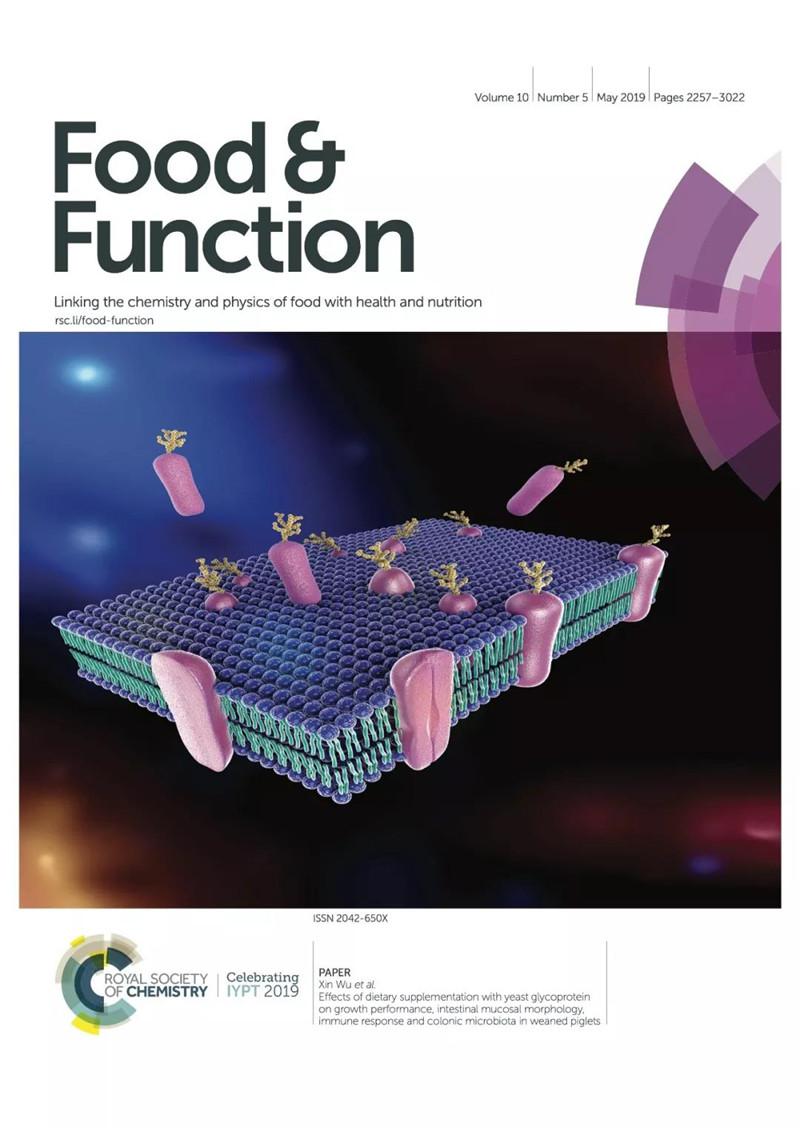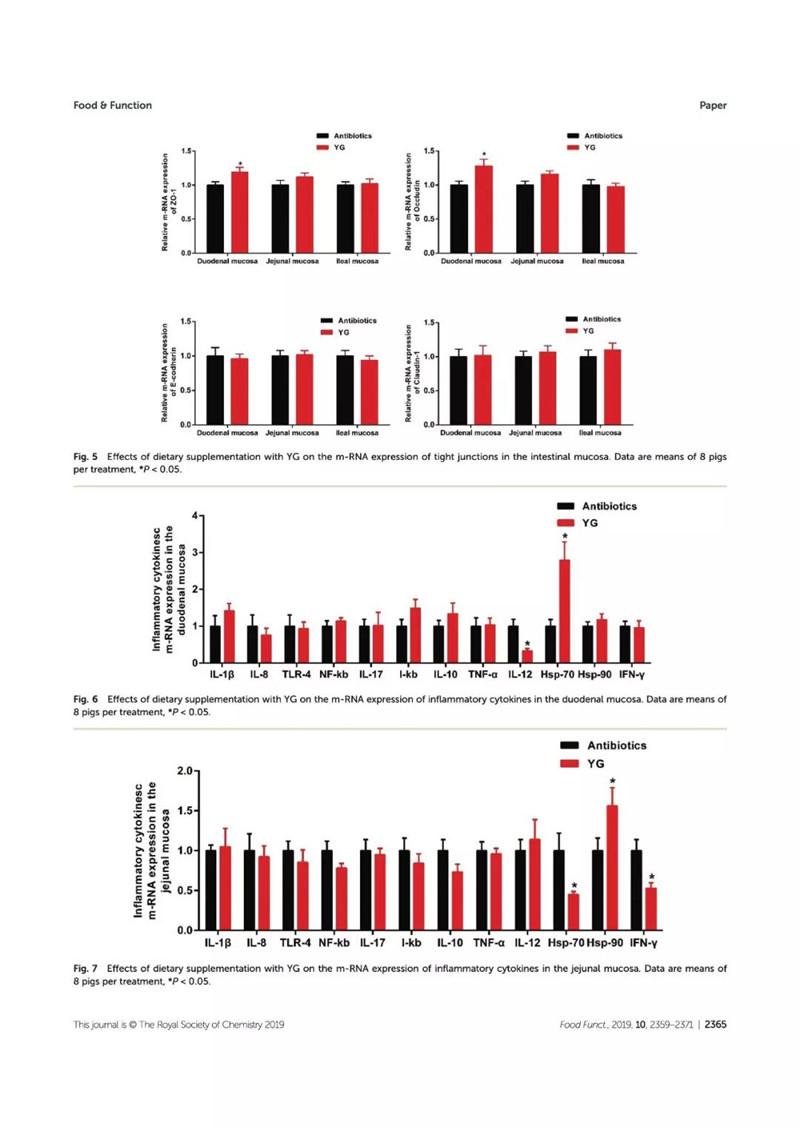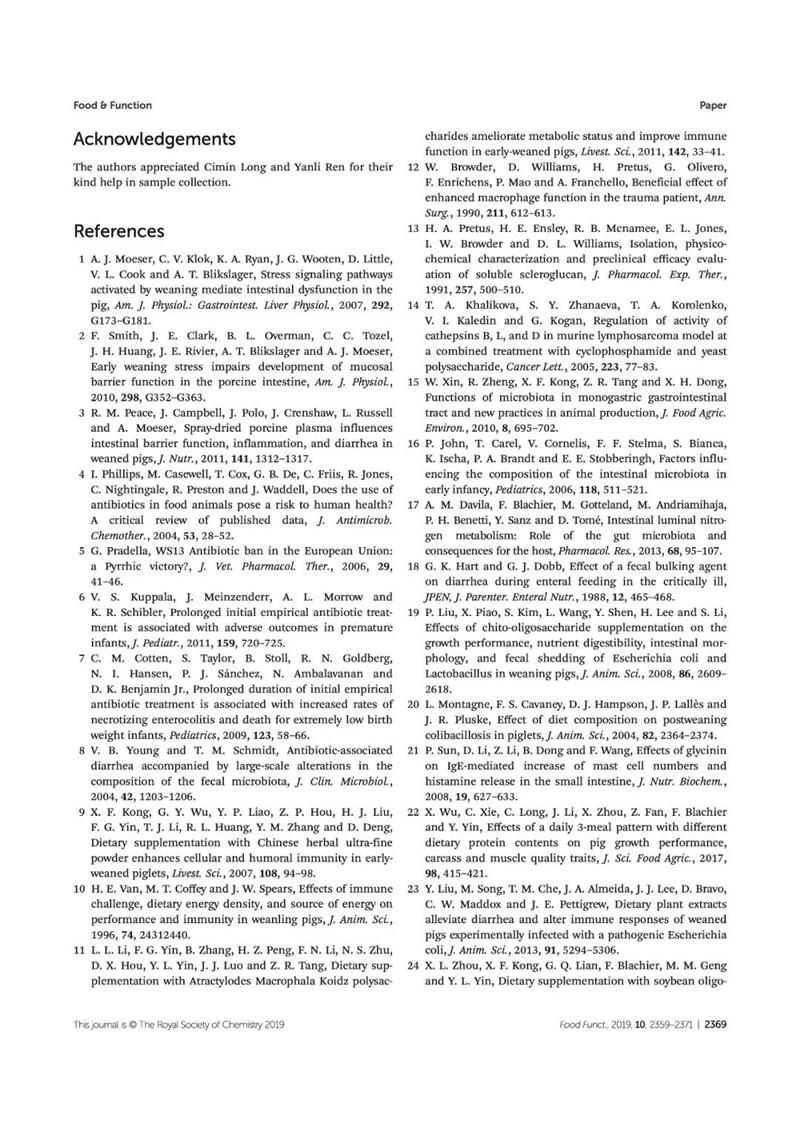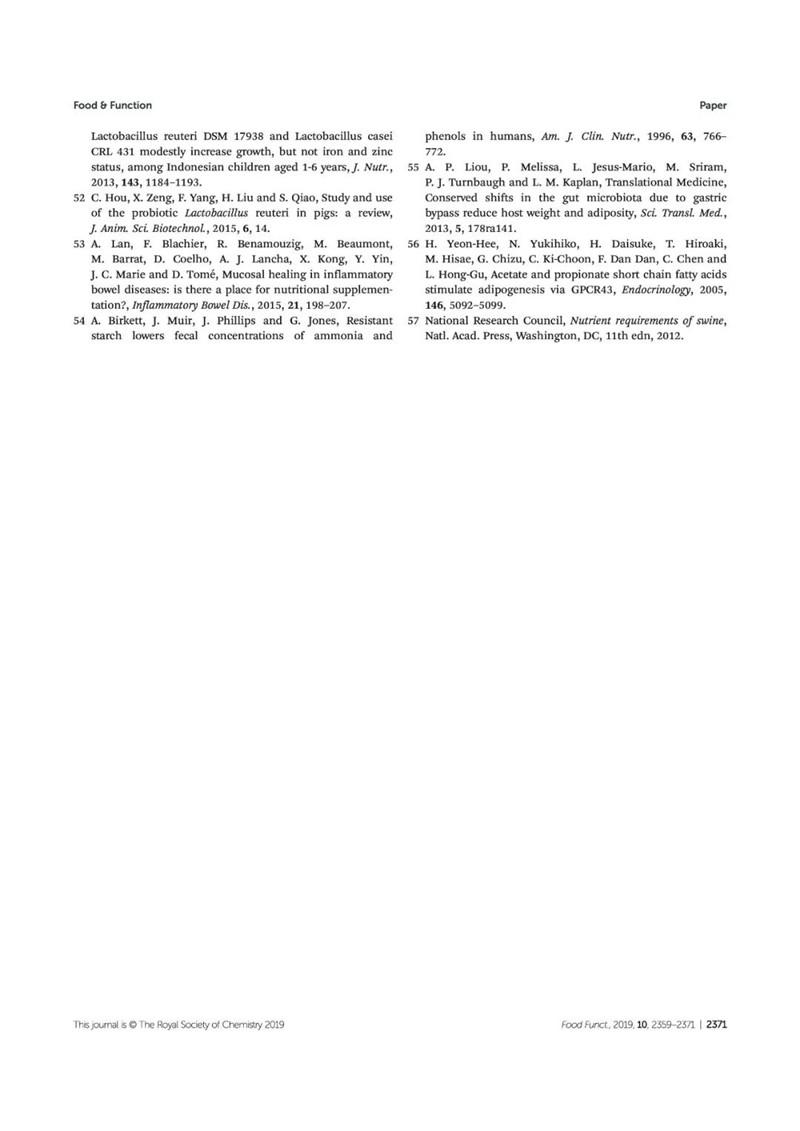关于亢可替的科研论文作为封面文章在SCI收录期刊《Food&Function》2019年5月第五期第十卷中发表。《Food & Function》是Royal Society of Chemistry出版社旗下的国际著名科学期刊,分区是SCI一区,影响因子3.289。
在文中亢可替被称为 “酵母糖蛋白”,这意味着在替代抗生素应用领域,酵母类产品取得了突破性研究进展。
该论文是由安琪酵母股份有限公司与中国科学院亚热带农业生态研究所 联合发表,研究了亢可替在断奶仔猪日粮中替代 AGPs 后,仔猪生长性能、肠道黏膜形态、免疫应答和结肠微生物群的变化情况。试验结果证明,亢可替是一种有效的抗生素替代品 。

图1:本期期刊封面

图2:期刊影响因子
试验动物为240头断奶仔猪, 在日粮中用800g/t亢可替取代 25% 喹烯酮200g/t +4%恩拉霉素 800 g/t 。研究结果如下:
提高断奶仔猪生长性能
提高期末体重 (0.05<P<0.1) ,提高日增重 (P<0.05) 、降低料肉比 (P<0.05)。
改善肠道健康
1、维护肠道屏障
对血清 DAO 检查可以揭示肠粘膜损伤程度。在肠粘膜上皮细胞和屏障功能受损的情况下, DAO 的释放增加, DAO 进入细胞外空间、淋巴管和血流,从而提高了血清 DAO 的水平。因此, DAO 的活动是肠道屏障结构损伤和修复的标志,反映了肠道上皮细胞的成熟程度和肠道粘膜的通透性。抗生素组中的仔猪含有更多的 DAO ,表明抗生素对仔猪肠粘膜有一定程度损害。而亢可替可降低 DAO (二胺氧化酶)的血清含量( P < 0.01 )。
2、促进肠道黏膜发育,确保肠道结构完整性
组织学评价表明,亢可替通过增加回肠绒毛高度(P<0.05)、降低回肠绒毛深度( P<0.01 )、降低回肠绒毛宽度( P<0.05 )来促进肠道发育。亢可替通过提高十二指肠和空肠黏膜中紧密连接蛋白的 m-RNA 表达量( P<0.05 )来确保肠道结构的完整性。
3、增加乳酸菌相对丰富度
结肠微生物群结果表明,亢可替的添加增加了乳酸菌的相对丰度(P<0.05)。
缓解炎症
有趣的发现,亢可替能缓解炎症。在十二指肠黏膜中,亢可替降低了IL-12(白细胞介素 -12 )的 m-RNA 表达( P<0.05 ),提高了 Hsp-70 (热休克蛋白 -70 )的 m-RNA 表达( P<0.05 )。在空肠黏膜中,亢可替降低了 Hsp-70 的 m-RNA 表达( P<0.05 ),降低了 IFN- γ( P<0.05 ),提高了 Hsp-90 的 m-RNA 表达( P<0.05 )。在回肠黏膜中,亢可替提高了 Hsp-70 的 m-RNA 表达( P<0.05 )。表明亢可替不仅减少了全身炎症,还减少了局部炎症。
降低饱腹感
结肠代谢物检测结果表明,亢可替可降低乙酸盐含量(P<0.05)。乙酸盐属于微生物发酵产物短链脂肪酸( SCFAs )的一种,而且是外周循环中zui丰富的 SCFAs ,乙酸盐通过中枢稳态机制穿过血脑屏障,并降低食欲。而亢可替可以降低肠道乙酸盐含量,从而降低饱腹感,提高采食量。
论文 原文 摘要
《Effects of dietary supplementation with yeast glycoprotein on growth performance, intestinal mucosal morphology, immune response and colonic microbiota in weaned piglets》
Antibiotics are commonly provided to weaned piglets, however, this practice has become controversial due to increased occurrences of microbial resistance, and alternatives are needed. This study aimed to investigate the effects of dietary supplementation with yeast glycoprotein (YG) or antibiotics on growth performance, intestinal mucosal morphology, immune response and colonic microbiome in weaned piglets. A total of 240 weaned piglets (d 23 ± 2) from 16 pens (15 piglets/pen) were randomly assigned into an antibiotics group (25% Quinocetone 200 mg/kg and 4% Enduracidin 800 mg/kg of the basal diet), or a YG group (800 mg/kg YG of the diet), respectively. One piglet per pen was chosen to collect plasma, intestinal tissue and colonic digesta samples after 14 days feedings. The results indicate that piglets fed diets containing YG tended to increase final body weight (0.05<P<0.1), increased average daily gain (P<0.05) and decreased F/G (P<0.05) when compared with antibiotics group. Moreover, intestinal permeability showed that YG led to lower serum content of DAO (P<0.01). Histological evaluations showed that YG contributed to improving the intestinal development via increasing villous height (P<0.05) and the villous height to crypt depth ratio (P<0.01), decreasing crypt depth (P<0.01) and villous width (P<0.05) in the ileum. Intestinal integrity also showed that YG conduced to improving the intestinal development via upregulating the m-RNA expression of occludin (P<0.05) in the duodenal and jejunal mucosa. Interestingly, YG supplement downregulated the m-RNA expression of IL-12 (P<0.05), upregulated the m-RNA expression of Hsp-70 (P<0.05) in the duodenal mucosa, downregulated the m-RNA expression of Hsp-70 (P<0.05), IFN-γ (P<0.05), upregulated the m-RNA expression of Hsp-90 (P<0.05) in the jejunal mucosa, and upregulated the m-RNA expression of Hsp-70 (P<0.05) in the ileal mucosa. On the other hand, colonic microbiome results showed that YG supplement increased the relative abundance of Lactobacillus (P<0.05). Colonic metabolites results showed that YG supplement decreased the content of acetate (P<0.05). Taken together, it is speculated that YG would be a potent alternative to prophylactic antibiotics in improving the gut health in weaned piglets.
论文原文
















